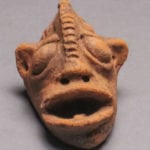 Weird Stuff
Weird Stuff  Weird Stuff
Weird Stuff  Mysteries
Mysteries 10 Tragic Disappearances and Deaths in Joshua Tree National Park
 History
History 10 Ways Childhood Really Sucked in the Old West
 Music
Music 10 Name Origins of Famous Bands from the 1990s
 Religion
Religion 10 Biggest Turnarounds by the Catholic Church
 Weird Stuff
Weird Stuff 10 Unbelievable Times Laws Had Unintended Consequences
 Humans
Humans Ten Historic Women Who Deserve Way More Credit Than They Got
 Movies and TV
Movies and TV 10 Films That Spawned Major Lawsuits
 History
History Ten Times Towns Were Wiped Off the Face of the Earth
 Creepy
Creepy 10 of the Most Disturbingly Haunted Public Houses in the UK
 Weird Stuff
Weird Stuff 10 Niche Subcultures That Are More Popular Than You Might Think
 Mysteries
Mysteries 10 Tragic Disappearances and Deaths in Joshua Tree National Park
 History
History 10 Ways Childhood Really Sucked in the Old West
Who's Behind Listverse?

Jamie Frater
Head Editor
Jamie founded Listverse due to an insatiable desire to share fascinating, obscure, and bizarre facts. He has been a guest speaker on numerous national radio and television stations and is a five time published author.
More About Us Music
Music 10 Name Origins of Famous Bands from the 1990s
 Religion
Religion 10 Biggest Turnarounds by the Catholic Church
 Weird Stuff
Weird Stuff 10 Unbelievable Times Laws Had Unintended Consequences
 Humans
Humans Ten Historic Women Who Deserve Way More Credit Than They Got
 Movies and TV
Movies and TV 10 Films That Spawned Major Lawsuits
 History
History Ten Times Towns Were Wiped Off the Face of the Earth
 Creepy
Creepy 10 of the Most Disturbingly Haunted Public Houses in the UK
10 Mighty Pieces Of Mythological Fashion
Mythology is full of magical additions to heroes’ and villains’ wardrobes. A deal with gods or devils is usually enough to produce an item of clothing with amazing powers. From the belts of strength to mantles for exposing cheating spouses, there’s an item for every occasion.
10Draupnir

Meaning “dripper,” Draupnir was Odin’s ring of endless wealth. While his famed spear Gugnir was renowned for its power in combat, his magic ring was far more important in maintaining his rule over the realms. Every nine days, it dripped eight rings of equal size and weight. During the time Odin was worshiped, kings rewarded their vassals by dealing out gifts such as rings. Having an endless supply of gold rings made Odin the greatest ring-giver in all the realms and the greatest potential lord.
Yet even though Draupnir was of paramount importance in securing Odin’s reign, the All-father once gave it away. Odin’s favorite son, Balder, had just died. In Norse style, his corpse was placed on a funeral ship to be burned at sea. Each of the gods laid a treasure in the boat to send him on his way, but Odin had been so devastated by his son’s death that he offered Draupnir in his grief. Without his magic ring, though, he could not maintain his rule over the realms. So to restore order, Odin had to set out to Hel’s underworld domain to reclaim his ring and restore his authority.
9The Hide Of Leviathan

According to ancient rabbinic literature, there were two giant sea creatures named Leviathan, one male and the other female. God thought that if the two creatures mated, their offspring would overrun the world, so he killed the female and castrated the male. (The male was apparently castrated even after the female died, to make him more docile.) It was said that the first clothing of Adam and Eve was made from the hide of the unfortunate dead female, which glowed with a brilliant light. The flesh of the female leviathan was then put on salt for a feast for the righteous after God’s coming.
The male leviathan was later killed in some spectacular Roman Colosseum–style event arranged by the angel Gabriel. Gabriel tried to drag the beast out of the ocean and kill it, but he failed. Ultimately, God Himself had to slay it.
Later, the brilliant, luminous hides of the leviathans were be parceled out to the righteous for tents and clothing with the size and type dependent on their righteousness. The best got tabernacles. The lesser got hats; the still lesser got necklaces. The worst got amulets. Any remaining hide decorated the banquet hall of the great feast.
8The Wolf-Shirts

The Volsunga Saga, an old Norse legend, has the hero Sigmund and his son Sinfjotli finding two “wolf-shirts” that turn men into wolves.
On a romp through the forest looking for spoils, they come upon a house with two men fast asleep. Seeing great gold rings and two wolf-shirts hanging above them on the wall, the men realize they are the king’s sons. The princes are skin-changers who don the wolf-shirts to become wolves. The magic works so that wearing the wolf-shirts turns the wearer into a wolf for nine days, then on the tenth, they can remove them.
Sigmund and his son take the shirts and try them out. They find that, just like the king’s sons, they cannot remove the shirts. So the pair decide to enjoy the spell that has taken hold of them by traveling deep into the forest and slaying men until they are exhausted. On the tenth day, they return to the princes’ hidden house and remove the wolf shirts. They decide they’ve had enough of being wolves and burn them.
7Thor’s Belt And Gloves

While Thor’s hammer, Mjolnir, has been made popular though the Marvel movies, it is not his only magical item. He also has a magic belt and gloves received from the giantess Grid.
Loki had been flying around the home of a wicked giant Geirrod in falcon-form when he was captured and tortured. Held in a cage without food or water, Loki eventually promised the giant he would help kill Thor. After flying back to Asgard, the trickster god convinced Thor to travel unarmed to Gierrod’s castle to meet his beautiful daughters.
On the way, they stayed overnight in the abode of the friendly giantess Grid, who, sensing Geirrod’s intentions, gave Thor Megingjoro, a magic belt that doubled his strength. Aside from that, she also offered him a pair of iron gloves named Jarngreipr, as well as a staff. The staff, combined with the added strength obtained from Megingjoro, saved him from the attacks of Geirrod’s daughters. As for Geirrod himself, when he tried to throw a lump of hot coal at Thor, the god of thunder caught it with his iron gloves and threw it back at him, killing the giant.
Another legend has him receiving Mjolnir after already being in possession of his belt and gloves. In this story, the gloves proved particularly useful since they allowed him to grip the somewhat imperfect hammer. In this version, Mjolnir was forged after Loki challenged the dwarf brothers Brokkr and Sindr that they could not create anything better than sons of the dwarf Ivaldi (who had just fashioned Gungnir and other treasures). The brothers accepted, but as they were fashioning the hammer, Loki disrupted its forging by becoming a fly and biting one on the eyelid. The result was that Mjolnir’s handle was made too short. Fortunately for Thor, the Jarngreipr and the strength given to him from Megingjoro allowed him to grip it properly.
6The Chastity-Testing Mantle

While most Arthurian legends are chivalric in tone, this one pokes fun at his court’s chastity.
Arthur is getting ready for supper, but before it begins, a young man arrives and asks a favor of the king. He won’t say what it is. He does, however, explain that the favor will not damage Arthur’s honor or kingdom, so the king agrees. The young man pulls out a beautiful, gold-embroidered mantle that will not fit if a woman has not been faithful. He says that all the women in the court must try it on at once.
The ladies try it on. Guinevere, of course, does not pass the test. When another woman tries on the mantle, it recedes in the back so that it barely reaches the hollow of her knee. In the front, it’s even shorter. And, in like fashion, the mantle exposes every woman’s sex life, down to which leg she lifted and which particular position she preferred.
After the entire court fails to pass its test, one maiden who has remained in her room because of an illness is called. The mantle fits her perfectly, and she receives it as a gift in acknowledgement of her purity. Later, she gives it to a monastery.
Although the mantle tested the chastity of the women at court, it might have been interesting if the men had tried it on, too. Those kinds of stories, though, weren’t written in those times.
5Vioarr’s Thick Shoe

The Norse god Vioarr, or Vidar, had one purpose: to avenge his father Odin at the end of days by killing the giant wolf Fenrir, who would eat the elder god. To that end, he takes a vow of silence to show his dedication to carrying out his duty to his father. It was said that Vioarr was so intent on killing the wolf that he didn’t attend to daily matters like keeping the grass in his domain tidy. More than anything, though, Vioarr has a thick shoe that at the end of days he will use to stomp on the wolf’s lower jaw. He’ll then pry open its mouth until he kills it.
He only uses one hand and foot, though, so the Norse god’s footwear was quite unsymmetrical. It was said that Vioarr’s thick shoe was made from all the spare parts of all the shoes in history—specifically, pieces cut from the toe and heel. So it was believed that all shoemakers who wanted to help the Norse gods during Ragnarok should throw any extra pieces away.
4Peter Stubbe’s Wolf Belt

The German town of Bedburg was once besieged by wolves. Attacks were frequent, and many died. In an effort to curb the local wolf population, the villagers went wolf-hunting. They came back claiming to have hunted down and cornered a particularly vicious wolf, and once they tried to kill it, the creature stood on its hind legs and turned into a man.
The villagers’ story wasn’t exactly believable, but they really did come back with a man. That man was Peter Stubbe, a local of the village, who claimed that he’d been practicing sorcery since he was 12 years old. He also claimed that he had made a pact with the devil and received a magic belt that transformed him into a wolf. Wearing the belt, he had killed many victims and drunk their blood, most often young girls milking cows in the fields.
One of the most interesting parts of Stubbe’s confession was that he claimed to have killed two men and a woman who had wandered close to the forest where he hid. The mangled bodies of the men were later found, but since the woman’s was never recovered, it was assumed that Stubbe devoured her whole.
We can assume that Stubbe was not really a werewolf, but he really was beheaded for his supposed crimes. And people started to wonder who else among them might be secretly transforming to wolves at night.
3Talaria

The Talaria were Hermes’s winged, gold, indestructible sandals made by Hephaestus, the blacksmith of the gods. It was said that while wearing the Talaria, Hermese could soar on the skies like a bird, though exactly how fast that was is a matter for scholarly debate. In the Aeneid, Homer depicts him being carried by the winds, gliding. Later translations have him soaring on his own power. Either way, Hermes’s ability to fly swiftly designated him the messenger of the gods. And as important as they were to his godly duties, he apparently kept one or more backup pairs, one of which he lent to Perseus when he went to slay the Gorgon.
Occasionally, though, Hermes went on foot. For those journeys, he didn’t wear his magical sandals. In one parody epic, Hermes has to walk across the countryside just like mortal men. But since his sandals are light and built for flying, he quickly patches together a pair of walking boots. Hermes makes them so quickly and haphazardly, though, that he puts twigs and leaves sticking out the side in place of wings.
2Helskor

Helskor, literally “Hel-shoes,” were worn so the dead could transverse the difficult journey to the underworld goddess Hel’s realm. Though legends are incomplete and often contradictory, it appeared that the road to Helheim (Hel’s underworld) was fraught with obstacles to cause weary travelers a great deal of foot pain. There was a thorny area they had to transverse, but the main obstacle was a river. Legends vary about the river’s particular dangers, from poison to sharp edges, to a flow of clanging weapons, but they all agreed a special means was needed to pass.
In one legend, when the god Baldr died, Odin sent him on his way to the underworld with a pair of iron shoes to make the journey. Another says that those who showed mercy in their lives were allowed to take a pair of shoes that hung from a tree at the beginning of their journey. Those who did not have any Helskor had to brave the river barefoot and received horrible wounds, which, fortunately, would heal as soon as they arrived on the opposite bank. While legends differ, they were all well-known in the old Norse world. The loved ones of the deceased would make sure to fashion a pair of Hel-shoes for the recently departed’s way to the domain of Hel.
1The Fool’s Wand

Perhaps the most dangerous creature of old Irish mythology was the Amadan-na-Briona, the Fool of the Forth. When he wasn’t invisible, the creature often took the appearance of a jester—or other bizarre manifestations—that gave him the name “Fool.” His appearance was not the only reason for being called a “fool.” He was completely insane and carried around a wand or rod that would either kill those he struck or take their wits, rendering them fools like himself. At times, though, he would just possess people in their sleep and deliver his “stroke” (as it was called) through them.
A stroke from the Fool’s wand was one of the most feared dangers of mythological Ireland because nothing could cure it. And since he was insane, there was no reasoning with him either. He selected his victims by chance and tended to favor the month of June for delivering his touch, so all had to be particularly wary of the Fool and his wand around that time.
Nathan keeps a Japan blog where he writes about the sights and expat life and finds Japanese culture in everyday items. You can also find him on Facebook and Twitter.








